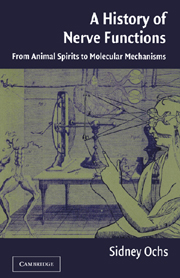Book contents
- Frontmatter
- Contents
- Preface
- 1 Introduction: Greek Science and the Recognition of Nerve as a Channel
- 2 Galen's Physiology of the Nervous System
- 3 Nerve, Brain, and Soul in the Middle Ages
- 4 Renaissance and the New Physiology
- 5 New Physical and Chemical Models of Nerve in the Enlightenment
- 6 New Systematizations of Nerve Function in the Enlightenment
- 7 Electricity as the Agent of Nerve Action
- 8 Nerve Fiber Form and Transformation
- 9 Wallerian Degeneration: Early and Late Phases
- 10 Nerve Regeneration
- 11 Characterization of Axoplasmic Transport
- 12 Molecular Models of Transport
- 13 Actions of Neurotoxins and Neuropathic Changes Related to Transport
- 14 Purposeful Reflexes and Instinctive Behavior
- 15 Neural Events Related to Learning and Memory
- 16 Epilogue: With Observations on the Relation of the Nervous System to Mind
- Bibliography
- Index
6 - New Systematizations of Nerve Function in the Enlightenment
Published online by Cambridge University Press: 13 August 2009
- Frontmatter
- Contents
- Preface
- 1 Introduction: Greek Science and the Recognition of Nerve as a Channel
- 2 Galen's Physiology of the Nervous System
- 3 Nerve, Brain, and Soul in the Middle Ages
- 4 Renaissance and the New Physiology
- 5 New Physical and Chemical Models of Nerve in the Enlightenment
- 6 New Systematizations of Nerve Function in the Enlightenment
- 7 Electricity as the Agent of Nerve Action
- 8 Nerve Fiber Form and Transformation
- 9 Wallerian Degeneration: Early and Late Phases
- 10 Nerve Regeneration
- 11 Characterization of Axoplasmic Transport
- 12 Molecular Models of Transport
- 13 Actions of Neurotoxins and Neuropathic Changes Related to Transport
- 14 Purposeful Reflexes and Instinctive Behavior
- 15 Neural Events Related to Learning and Memory
- 16 Epilogue: With Observations on the Relation of the Nervous System to Mind
- Bibliography
- Index
Summary
With the overturn of the old physiology underpinning Galenic medicine, new physiological foundations for medicine were searched for. Systems based on new physical principles proposed by Galileo and other physicists, and those on chemistry following its transformation from alchemy, were advanced: on physical principles by the iatrophysicists and on chemical principles by the iatrochemists. Both groups proposed agents to replace the ancient concept of animal spirits, but they essentially represented only a change of name. Alongside the nervous system by which sensations were perceived and motor nerves innervating muscles expressed the will, an involuntary nervous system was recognized – one by which the various bodily organs and its movements were carried out independently of the will (autonomously). Since Galen, the intercostal nerve chains were known, but were thought to be an offshoot of the vagus nerve originating from the brain, and it was so figured by Vesalius. These chains were then recognized as not connected directly to the brain, having its origin in neural connectives from the spinal cord. How the ganglia associated with this system, the intercostal chains and the ganglia found elsewhere with the involuntary nerves in the abdomen, their relation to the voluntary nervous system, and mode of action, became a matter of inquiry.
BOERHAAVE'S SYSTEM OF NERVE FIBERS
One of the most eminent clinicians of his day who incorporated the developments in physics and chemistry into a new system of physiology and medicine was Hermann Boerhaave (1668–1738), whose influential six-volume compendium, Institutiones medicae, was aimed at eliminating metaphysics from medicine and medical science.
- Type
- Chapter
- Information
- A History of Nerve FunctionsFrom Animal Spirits to Molecular Mechanisms, pp. 93 - 107Publisher: Cambridge University PressPrint publication year: 2004



